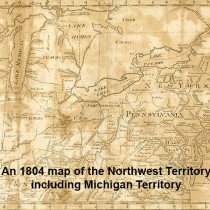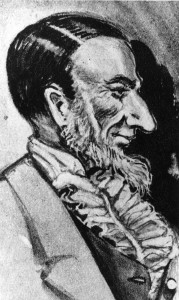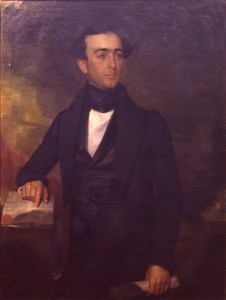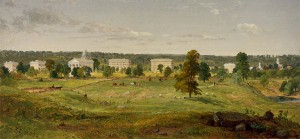Snapshots of U-M History

Rising from the Ashes
How a fire, a new location for the state capitol, and a tongue-tying, seven-syllable word led to the University of Michigan’s creation.
by Rob Havey
Chief Federal Judge Augustus Woodward, weary from his four month journey from Washington, D.C., arrived at his posting in Detroit only to find the entire town had been reduced to still-smoldering ashes. It was June 30, 1805, just 19 days after a fire had turned his new home into a ruin. This was a bad start for a man tasked by President Thomas Jefferson to develop the untamed Michigan Territory into something worthy of statehood.
Woodward was a thin, eccentric man of high society and high learning, very much out of his element in the wilderness of early 19th-century Michigan. During the rebuilding of Detroit, he met fellow intellectual Father Gabriel Richard, a French-born missionary and teacher. He and Richard became friends, discussing the French Enlightenment and history while working to resurrect the town. Their efforts are memorialized with Woodward’s name on famous avenue and Richard’s words adorning the flag of Detroit: “Speramus meliora; resurget cineribus” or “We hope for better things; it will arise from the ashes.”
A Complete Education
Even in their humble environment far from civilization, Richard and Woodward believed deeply in classical education. Their conversations motivated Woodward to publish a book in 1816 titled A System of Universal Science, which detailed 13 “didaxim,” or subjects, that make up a complete education. The pair decided to bring these lofty ideas to life with a new type of school for a reborn Detroit. In a burst of classical-era zeal, he christened the new school “Catholepistemiad, or The University of Michigania.” The seven-syllable Catholepistemiad was most likely coined by Woodward. The mish-mash of Latin and Greek translates to roughly “School of Universal Knowledge.”

Augustus Woodward was the first Chief Justice of the Michigan Territory and a founder of the University of Michigan.
The structure of public education proposed in Woodward’s book is essentially what university education consists of today. Almost all of the didaxims outlined in the book correspond to current degree programs, such as Anthropoglossica, Mathematica, and Physiognostica (literature, math, and science).
The law establishing the school was passed by the Territorial Legislature on August 26, 1817.
Construction started on the two-story white wooden building on September 24, 1817. It’s likely the school functioned as only a primary school at first, teaching the children of Detroit reading and arithmetic. The school had very few students and even fewer who could possibly hope to grasp the Latinate concepts detailed in Woodward’s book.
Richard tried to carry on the vision of Woodward as vice president of the school, but he met resistance from the other instructors. William Woodbridge, an early collaborator, begged his colleague to acknowledge the reality of teaching on the frontier: “With a population of less than 7,000 people, with all of the difficulties in communication, in resources, and in the problem of subduing the wilderness, so real and pressing, it was hard […] to follow with him in the extensive, […] impractical planning of this means of education.”
Pedantic and Uncouth
Catholepistemiad gained the notice of high-ranking Michigan officials. Unfortunately, it was only for its silly name. Michigan Governor Lewis Cass called it “pedantic and uncouth.” Woodward’s fellow justice, James V. Campbell, said the name was “neither Greek, Latin, nor English” and “a piece of language gone mad.” Governor Cass and two territorial judges wrote a law to change the name and to put the control of the school in the hands of a board of trustees. Catholepistemiad officially became The University of Michigan on April 20, 1821.
Both Woodward and Richard eventually moved on to higher positions in state politics while their replacements struggled to keep the school out of financial ruin. The University of Michigan may have faded into obscurity then if not for the massive reorganization following Michigan statehood in 1835. Governor Stevens T. Mason’s ambitious education plan included a publicly funded state university. The University of Michigan’s further existence was assured, at least on paper.
Location, Location, Location
The people of Ann Arbor assumed that when Michigan became a state, their town would become the new capital. Detroit had been explicitly ruled out as an option in the state charter, and Ann Arbor was one of the very few places in Michigan that had a population of more than 1,000 people. So confident were they in being chosen, the new road that ran through the would-be capital was named State Street. All were flabbergasted when the legislature chose a barren location in the middle of the state called Lansing.
The effort did not entirely go to waste. After losing the bid for the capital, Ann Arbor was proposed as a site for the newly enshrined state university. Governor Mason agreed that it was the ideal place and went about securing funding for the construction. The first Regents meeting was held on June 6, 1837. The first class, seven students in all, began four years later.
U-M has since grown into a world-class institution, far beyond its humble origin, but the seeds of its highest ideals were there in the white schoolhouse in Detroit. Among the grand plans drawn up by Judge Woodward were instructions for the University’s first seal. On it was a lone word which is still at the core of U-M today: “Epistemia.” Knowledge.


